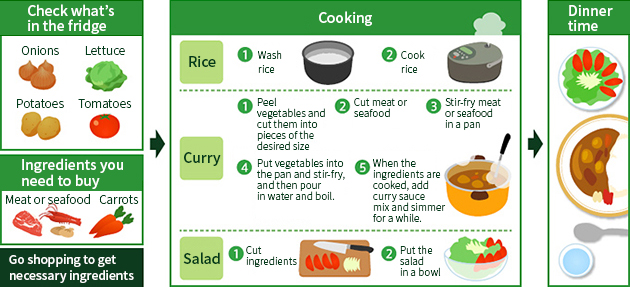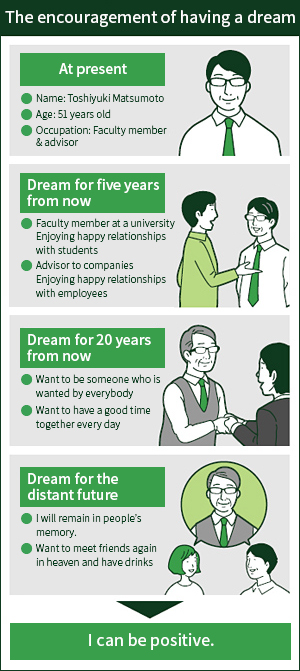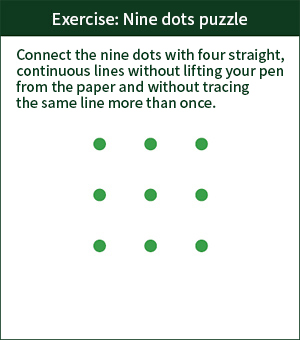Assume that you are going to cook for your family. What would you think of first?
You would probably ask yourself the following questions, although the order may be different from person to person:
What should I make?
What’s in the fridge?
Are there any ingredients that I don’t have on hand?
Do I need to go shopping?
What time will we eat?
How should I make it?
Assume that you are going to make curry and rice, and salad. You have onions, potatoes, lettuce and tomatoes in your fridge. In addition to these, you will need meat or seafood and carrots for curry. You may need to go to a supermarket to get them, or you will ask a family member to buy the necessary ingredients on their way home.
Now, you will start cooking: You will wash the rice and put it in a rice cooker, and cut the meat and vegetables for the curry. While you are cooking the ingredients of the curry, you make a salad. In this way, stay-at-home wives (husbands) use their mind so that everything is ready at dinner time.

In this way, housewives do a lot of thinking and use their brain to the full when they cook for their families. In cooking, there are basic elements of the Industrial Engineering (IE) I am going to discuss, such as “inventory management” in the fridge; “cost calculation” and “budget control” relating to money; “quality control” for tastiness; and “production management” to schedule tasks for efficiently cooking dishes; and “work process management” as to how to layout kitchen utensils in order to pick up the necessary item quickly.
According to the Japan Institute of Industrial Engineering, IE is an activity to explore ways to provide quality products and services demanded by the market inexpensively and in a timely manner and to bring satisfaction and happiness to people, by effectively using management resources, such as manpower, goods, money, information and time, through a scientific approach.
In the context of the “cooking activity” of housewives, IE can describ as the following: Using goods (food ingredients), money and time efficiently and effectively to offer delicious dishes to customers (family members) in a well-timed manner, in order to bring them satisfaction and happiness. Skillful housewives who manage to clean up while cooking deserve to be called professionals in IE.
To effectively use resources, such as manpower, goods, money, information and time, and to increase productivity, it is important to solve day-to-day problems, or make improvements. There is a phrase I would like the readers to remember as the philosophy of improvement.
”There is always a better way.”
Assume that a mother is having a problem: Cooking takes too much time and she falls behind in all other chores. As a result, she is unable to have enough time to sleep. She would analyze the issue, identify problems and streamline the cooking procedures and time, in order to secure enough time to sleep the next day. This process is called improvement. To make an improvement, it is important to firstly have a dream and a goal.

I am now 51 years old. I am teaching at university and helping companies in their improvement efforts. As a dream for five years from now, I would like to enjoy my research together with students (as a faculty member) and to continue helping corporates in their improvement activities. To this end, I need to increase interesting research themes and enhance my own ability to improve. After retirement, I wish to be a person needed by others and spend an enjoyable time with people every day. In the distant future, I would like to have more friends whom I want to meet again and have drinks together in heaven, and remain in people’s memory at and after my death.
By identifying our dreams in life, we can correctly grasp the current status, have dreams or ideal life images and identify what is necessary to achieve those goals. This is exactly what we call a problem-solving process. Don’t complicate things, and draw your dream while taking into account the following points.
1. Use pictures and cartoons
2. Depict your dreams timewise, such as a dream for the near future and that for the distant future
3. Draw the images of your dream by space, such as those specific to individual, family and work
4. Update near-future dreams every year
5. Take into account changes in the environment, including negative or bad situations
6. Have higher ideals
It is important to have a dream and wish for it. If you wish, there is a chance that your dream will come true. But if you don’t, nothing will happen. It is like a lottery that you will never win if you don’t buy tickets.
The greatest benefit of having a dream is that you can gain courage. Furthermore, a dream clears away restrictions, tell you what you should do now and make you confident to take the first step. The word “dream” makes you positive and cheerful.
Once you have a dream, start making small improvements toward your dream. Through making step-by-step improvements, you can grow and acquire the ability to improve. During this process, you are encouraged to follow the three steps broadly categorized shown in the following table.

Step 1 provides “key words for carefully observing phenomena.” It is extremely important in Step 1 to correctly grasp the current situation and identify what constitutes a problem, which is the starting point of improvement. A particular focus should be placed on looking and listening to the status closely as well as thinking simply.
Step 2 offers “key words for coming up with many good ideas.” Start with challenging your assumptions.
Step 3 lists “key words for making improvement for your dream.” Please try the following puzzle.

It is easy to connect the nine dots with five straight continuous lines. The problem here is that you can use only four straight lines. How will you solve the puzzle? The key for a solution is to look at it from a different angle.
At first glance, we tend to confine ourselves to the thought that we should draw the lines within the square area defined by the nine dots. However, when you extend one line outside the box and draw an arrow, you can connect the dots with four straight, continuous lines.
Going further, let’s think about this puzzle in cases three lines and one line are used.
Solutions to Exercise: Nine dots puzzle

In the case of three lines, the dots can be connected by extending the lines over the box and presuming that each dot has the dimension (the area of a circle) on which the line can run through obliquely to link the dots. In the case of one line, think that the line is thick enough to cover all the nine dots with one stroke. This allows one straight line to connect the nine dots.
In this way, even a seemingly clueless problem can be solved through not being swayed by stereotypical ideas and changing your perspective. Begin with small improvements, solve problems by changing your mindset and repeat these processes. Then, you will have a dream come true.
Industrial engineering is the area of study that first appeared in the United States in the 1900s. IE is especially noted for Toyota Motor Corporation’s lean production system. In the 1950s, late vice president Taiichi Ohno started factory floor reforms, which placed importance on the idea that a single second or minute on the factory floor matters. Centering on the elimination of the seven wastes, Just-In-Time (JIT) and Jidoka (automation with a human touch), this improvement activity has come to be well known and studied even today as a lean production system.
Last year, I studied at Pennsylvania State University for a year, where America’s and the world’s first department of industrial engineering was established. One third of the classes on production was about Japan’s kaizen improvement, focusing on Toyota’s lean production system. Japan’s monozukuri manufacturing, and associated techniques that enable continuous improvement are a subject that is continuously studied and acknowledged across the world and one that Japanese can boast to the world.
IE is a research area concerning activities to improve productivity through broadly studying people, goods, money, information and time, as well as identifying scientifically effective approaches. Data are collected, analyzed and schematized to clarify waste. IE is to determine what activities are needed for more efficiently improving productivity through eliminating such waste. IE is all about collecting and analyzing various data to make improvement toward a dream come true.
IE is effectively utilized at factories and companies throughout Japan and the world. The readers should reaffirm that IE is something you have already experienced in your daily lives and it is useful. I recommend you start making small improvements toward your dream. Then, let me ask this question since I believe this is the starting point:
“What is your dream?”
(This column is as of 2012.)